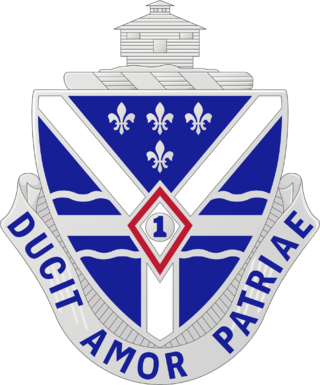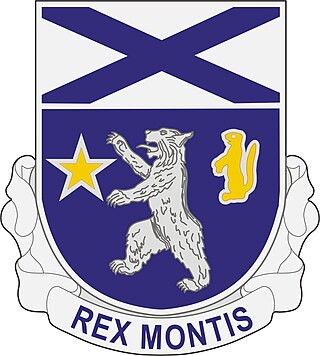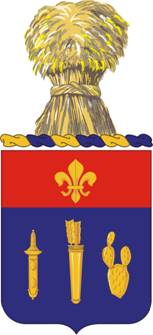Civil War
The 129th Infantry traces its lineage to the 11th and 12th Illinois Volunteer Infantry Regiments, constituted on 16 April 1861 and organized as three-month units from volunteers in northern Illinois, excluding Chicago. The 12th Illinois was mustered into federal service at Springfield, Illinois on 25 April, while the 11th Illinois was mustered into federal service at Springfield on 30 April; the 12th Illinois was mustered out at Cairo, Illinois, on 25 July, while the 11th Illinois was mustered out at Cairo on 30 July. The two regiments were reorganized at Cairo on 31 July-1 August, and following three-year reenlistment service, were again mustered out on 10 July 1865 at Louisville, Kentucky (12th), and 14 July 1865 at Baton Rouge, Louisiana (11th). [1]
Postbellum to World War I
Independent companies were reorganized in the northern part of the state, again excluding Chicago, as part of the Illinois State Guard from 1868-1873, and on 21 December 1875, they were consolidated to form the 3rd and 4th Infantry Regiments. On 1 July 1877, the Illinois State Guard was redesignated the Illinois National Guard. From 1882-1890, the companies were reassigned to the 3rd Infantry Regiment. The 3rd Illinois was mustered into federal service on 7 May 1898 for the Spanish-American War at Camp Tanner, Springfield, Illinois, as the 3rd Illinois Volunteer Infantry, and was mustered out of service on 24 January 1899 at Joliet, Illinois. The regiment was subsequently reorganized in state service as the 3rd Infantry in 1903. The 3rd Illinois was again mustered into federal service for the Pancho Villa Expedition on 29 June 1916, and was mustered out of service on 21 February 1917 at Fort Sheridan, Illinois. For World War I, the 3rd Illinois was called into federal service on 25 March 1917 and drafted into federal service on 5 August 1917. On 12 October 1917, the regiment was redesignated the 129th Infantry Regiment, 33rd Division. [2]
Interwar period
The 129th Infantry arrived at the port of New York on 23 May 1919 on the USS Leviathan as an element of the 33rd Division, and was demobilized 6 June 1919 at Camp Grant, Illinois. It was reconstituted in the National Guard in 1921, assigned to the 33rd Division, and allotted to the state of Illinois. It was partially organized in 1921 as the 3rd Infantry, Illinois National Guard, and redesignated as the 129th Infantry on 13 December 1921. The headquarters was organized on 30 January 1924 and federally recognized at Pontiac, Illinois, and relocated on 1 November 1930 to Sycamore, Illinois. The regiment, or elements thereof, was called up to perform the following state duties: tornado relief work at Carbondale, Illinois, 18 March–13 April 1925; martial law in connection with civil disorders in Mundelein, Illinois, 23–25 June 1926; three companies for riot control at the Joliet Prison Riot, 18–23 March 1931; 3rd Battalion acted as honor guard for President Herbert Hoover at the rededication of the Lincoln Tomb at Springfield, Illinois, 17 June 1931; entire regiment for strike duty at a coal miners’ strike at Springfield and Taylorville, Illinois, in March–April 1933; and three companies for strike duty at a labor strike in Freeport, Illinois, in June 1935. The regiment conducted annual summer training most years at Camp Grant, from 1922 to 39. For at least one year, in 1936, the regiment also trained some 15 company-grade infantry officers of the 86th Division at Camp Grant. It was inducted into active federal service at Sycamore on 5 March 1941 and moved to Camp Forrest, Tennessee, where it arrived 20 March 1941. [3]
Modern
The 129th Infantry was inactivated on 13 December 1945 at Camp Anza, California. On 5 July 1946, the regiment was relieved from assignment to the 37th Infantry Division and assigned to the 44th Infantry Division, which was reestablished as a National Guard division in Illinois. The regimental headquarters was organized and federally recognized on 18 December 1946 at Dixon, Illinois. [4] The regiment is now known as the 129th Regiment (Regional Training Institute), providing training for Illinois National Guard personnel at the Illinois Military Academy at Camp Lincoln, Springfield, Illinois. The 129th Infantry Drive in Joliet, Illinois is named in honor of the regiment.

The 33rd Infantry Division was a formation of the U.S. Army National Guard between 1917 and 1968. Originally formed for service during World War I, the division fought along the Western Front during the Battle of Amiens, the Battle of Hamel, the Meuse-Argonne Offensive, at the Second Battle of the Somme, and at the Battle of Saint-Mihiel. It was re-formed during the inter-war period, and then later activated for service during World War II, seeing action against the Imperial Japanese Army in the Pacific. In the post war era, the division was reconstituted as an all-Illinois National Guard division. In the late 1960s, the division was reduced to a brigade-sized formation, and its lineage is currently perpetuated by the 33rd Infantry Brigade Combat Team.

The 112th Infantry Regiment, also known as the Sixteenth Pennsylvania, is a unit in the Pennsylvania National Guard which can trace its lineage back to before the American Civil War.

The 132nd Infantry Regiment was an infantry regiment of the United States Army, part of the Illinois Army National Guard.

The 168th Infantry Regiment is an infantry regiment of the United States Army. The 1st Battalion of the 168th Infantry is part of the 2nd Infantry Brigade Combat Team, 34th Infantry Division, part of the Iowa Army National Guard.

The 163rd Infantry Regiment is a regiment of the Montana National Guard. It went overseas with the 41st Infantry Division in World War II.

The 146th Field Artillery Regiment is a field artillery regiment of the Army National Guard first Constituted in 1886 as the 1st, and 2nd Regiments of Infantry.
The 203rd Engineer Battalion is a combat engineer battalion of the Missouri Army National Guard.

The 113th Infantry Regiment is an Infantry regiment of the New Jersey Army National Guard. It is one of several National Guard units with colonial roots and campaign credit for the War of 1812.

The 130th Infantry Regiment is an infantry regiment in the Army National Guard. It is one of several Army National Guard units with campaign credit for the War of 1812.

The 133rd Infantry Regiment is an infantry regiment in the Iowa Army National Guard. It is represented by the 1st Battalion, 133rd Infantry Regiment, part of the 2nd Infantry Brigade Combat Team, 34th Infantry Division.

The 131st Infantry Regiment is an Infantry Regiment in the Army National Guard.

The 134th Cavalry Regiment is a cavalry regiment in the Nebraska Army National Guard. By extension, it is a member of the United States Army National Guard, and as a currently federally-recognized unit, also a member of the National Guard of the United States.

The 135th Infantry Regiment is an infantry regiment in the Minnesota Army National Guard.

The 136th Infantry Regiment is an infantry regiment in the Army National Guard.

The 107th Field Artillery Regiment is a Field Artillery Branch regiment of the United States Army. It has been affiliated with the Pennsylvania National Guard since its formation. It appears that the regiment last formally came into existence in June 1959, when the 107th Field Artillery Battalion was reorganized as the new Regiment's 1st Battalion in line with the Pentomic (ROCID) reorganization going on at that time.

The 106th Infantry Regiment was the designation of two separate New York Army National Guard regiments. The first is currently active as the 106th Regiment (Regional Training Institute), and the second is active as a result of consolidation with the 101st Cavalry Regiment.
The 122nd Field Artillery Regiment is a field artillery regiment of the Illinois Army National Guard. The regiment's 2nd Battalion is the cannon battalion assigned to the 33rd Infantry Brigade Combat Team.
The 120th Field Artillery Regiment is a field artillery regiment of the Wisconsin Army National Guard.

The 123rd Field Artillery Regiment is an active Field Artillery Branch regiment of the Illinois Army National Guard. The regiment's 2nd Battalion last served as a towed, 155mm cannon battalion assigned to the 169th Field Artillery Brigade, though administratively under the control of the 65th Troop Command.

The 125th Field Artillery Regiment is a field artillery regiment of the Minnesota Army National Guard. The regiment's 1st Battalion is the 155 mm, self-propelled cannon battalion assigned to the 1st Armored Brigade Combat Team, 34th Infantry Division.
This page is based on this
Wikipedia article Text is available under the
CC BY-SA 4.0 license; additional terms may apply.
Images, videos and audio are available under their respective licenses.


















